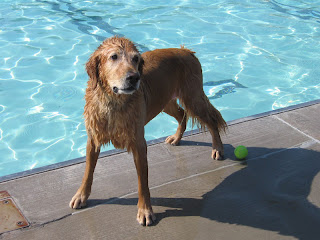The usually depressing weather in the Pacific Northwest cooperated for the most part, so we were able to get outside for a few days to see the island's sights. Toward the end of the week, we spent a few more days in Seattle at Jane's family's house just south of Green Lake, taking in the culture and celebrating Jane and Josh's twin sons Max and Ben's birthdays. On one of the Seattle days, Charlie and I bombed around downtown Seattle with a friend from high school, Paul Snyder, who lives in nearby Bellevue.
Before Charlie and I headed home, I promised to get pictures to everybody but I haven't yet. In the last few weeks, since we discovered Charlie's illness, I have been reviewing digital pictures of him on my computer. Many of them are from the family reunion, which reminded me of my promise, so family, I hope you're OK with this blog version of the pictures (click to see full-size views):
 The Lichty Kriesberg residence on Whidbey Island. Note the foggy weather and the moss growing on the roof. Puget Sound is visible from the house (on a clear day), across the street and down the hill. Brother Stuart, Charlie and I bunked in the little cabin out back.
The Lichty Kriesberg residence on Whidbey Island. Note the foggy weather and the moss growing on the roof. Puget Sound is visible from the house (on a clear day), across the street and down the hill. Brother Stuart, Charlie and I bunked in the little cabin out back. The back of the house, showing the nautical flair of the previous owner, a talented carpenter. Morning fog still hangs in the air. Weather permitting, cocktail hours were spent on the patio.
The back of the house, showing the nautical flair of the previous owner, a talented carpenter. Morning fog still hangs in the air. Weather permitting, cocktail hours were spent on the patio. Flying kites at Fort Casey State Park. Fort Casey is an abandoned World War II post intended to protect Puget Sound from naval invasion. Left to right are Dad, Jane (in the distance), sister Susan and John's son Peter, and Max.
Flying kites at Fort Casey State Park. Fort Casey is an abandoned World War II post intended to protect Puget Sound from naval invasion. Left to right are Dad, Jane (in the distance), sister Susan and John's son Peter, and Max. Visitors are allowed to climb around on the old fort, which still has some of its massive guns in place. This one looks capable of hitting Port Townsend, about three miles away across the Sound.
Visitors are allowed to climb around on the old fort, which still has some of its massive guns in place. This one looks capable of hitting Port Townsend, about three miles away across the Sound. Susan, Charlie and me on top of the Fort Casey ramparts, with Puget Sound in the background.
Susan, Charlie and me on top of the Fort Casey ramparts, with Puget Sound in the background.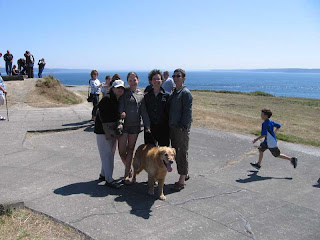 The ladies, plus Charlie, on top of the Fort Casey ramparts: Mom, Susan's daughter Kirsten, Susan and Jane. The land across the Sound is Port Townsend. That's Ben in mid-stride.
The ladies, plus Charlie, on top of the Fort Casey ramparts: Mom, Susan's daughter Kirsten, Susan and Jane. The land across the Sound is Port Townsend. That's Ben in mid-stride. Walking toward the stairs to the beach: Dad, Mom, Ben, Kirsten with Charlie, and Josh.
Walking toward the stairs to the beach: Dad, Mom, Ben, Kirsten with Charlie, and Josh.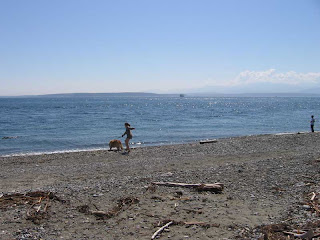 Kirsten trying to keep Charlie from dragging her into the water. Note the hazy view of the Cascade Mountains in the distance.
Kirsten trying to keep Charlie from dragging her into the water. Note the hazy view of the Cascade Mountains in the distance. Charlie experiences sea water for the first time. Of course, he thinks all water is drinkable so he drank enough that he puked it all up later in the back of Jane's van.
Charlie experiences sea water for the first time. Of course, he thinks all water is drinkable so he drank enough that he puked it all up later in the back of Jane's van. Josh sitting on a driftwood log on the beach, which is covered in so much driftwood that Peter sees if he can walk without touching the ground.
Josh sitting on a driftwood log on the beach, which is covered in so much driftwood that Peter sees if he can walk without touching the ground. The next day, most of us, including John and Susan, went to the Coupeville Wharf to see the classic square-rigger ships, The Lady Washington and The Hawaiian Chieftain, which were on display there for a short while. The Lady Washington was used in all three Pirates of the Caribbean movies.
The next day, most of us, including John and Susan, went to the Coupeville Wharf to see the classic square-rigger ships, The Lady Washington and The Hawaiian Chieftain, which were on display there for a short while. The Lady Washington was used in all three Pirates of the Caribbean movies. Max walking the rail down the center of the wharf toward the ships just visible over the building at the end. To the right is a good view of the public dock and Penn Cove.
Max walking the rail down the center of the wharf toward the ships just visible over the building at the end. To the right is a good view of the public dock and Penn Cove. View of The Hawaiian Chieftain and The Lady Washington from the end of the public dock.
View of The Hawaiian Chieftain and The Lady Washington from the end of the public dock. Susan and Kirsten aboard The Lady Washington.
Susan and Kirsten aboard The Lady Washington. As seen from The Lady Washington, a MacGregor 26X approaches the public dock. (They're everywhere! They're everywhere!)
As seen from The Lady Washington, a MacGregor 26X approaches the public dock. (They're everywhere! They're everywhere!)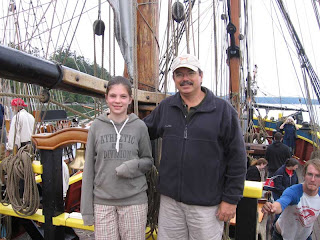 Kirsten and me on the poop deck of The Lady Washington.
Kirsten and me on the poop deck of The Lady Washington. John on the wharf in front of the Hawaiian Chieftain.
John on the wharf in front of the Hawaiian Chieftain. The next day, at the Smugglers Cove beach at the north end of South Whidbey Island State Park. Dad tries to talk Charlie out of his tennis ball while Mom, Stuart and John enjoy the view.
The next day, at the Smugglers Cove beach at the north end of South Whidbey Island State Park. Dad tries to talk Charlie out of his tennis ball while Mom, Stuart and John enjoy the view. Mom, Kirsten and Jane at the north end of the Smugglers Cove beach.
Mom, Kirsten and Jane at the north end of the Smugglers Cove beach. The Lichty men: me, Dad, Stuart and Charlie.
The Lichty men: me, Dad, Stuart and Charlie. Mom and Dad on the beach.
Mom and Dad on the beach.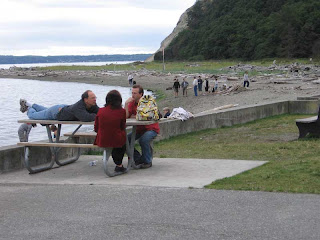 A very relaxed John has a conversation in German with a German couple he met at the Smugglers Cove beach while the rest of the group, in the background, examines a driftwood fort built by Peter, Max and Ben.
A very relaxed John has a conversation in German with a German couple he met at the Smugglers Cove beach while the rest of the group, in the background, examines a driftwood fort built by Peter, Max and Ben. The 50th anniversary celebration at the Edgecliff Bar & Grill in Langley, down the road from the Lichty-Kriesberg home on Whidbey Island.
The 50th anniversary celebration at the Edgecliff Bar & Grill in Langley, down the road from the Lichty-Kriesberg home on Whidbey Island. The whole group, roughly left to right: me, Susan, Peter, John, Max, Dad, Mom, Ben, Stuart, Kirsten, Jane and Josh.
The whole group, roughly left to right: me, Susan, Peter, John, Max, Dad, Mom, Ben, Stuart, Kirsten, Jane and Josh.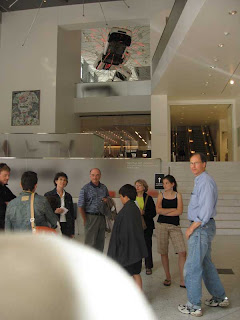 At the entrance to the Seattle Art Museum, before part of the group opted for the Seattle Aquarium instead.
At the entrance to the Seattle Art Museum, before part of the group opted for the Seattle Aquarium instead. My high school buddy Paul Snyder at the Hiram M. Chittenden Locks that connect Lake Union with Puget Sound on the west side of Seattle. Nice Catalina 320 behind him.
My high school buddy Paul Snyder at the Hiram M. Chittenden Locks that connect Lake Union with Puget Sound on the west side of Seattle. Nice Catalina 320 behind him.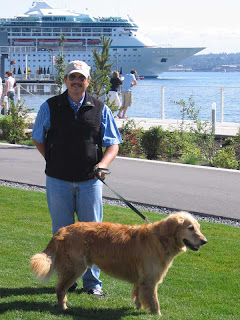 Charlie and me at the Sculpture Park near Myrtle Edwards Park.
Charlie and me at the Sculpture Park near Myrtle Edwards Park. Charlie wanting to cool off in the fountain at the Sculpture Park. He had to settle for a drink.
Charlie wanting to cool off in the fountain at the Sculpture Park. He had to settle for a drink.

 Raising Charlie: The Lessons of a Perfect Dog
Raising Charlie: The Lessons of a Perfect Dog



